Sleepaway Camp IV Workprint (Review)
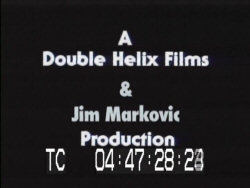 How do you make a movie from nothing? That's the question Jim Markovic faced in 1992. Hired to produce/direct Sleepaway Camp IV: The Survivor, the gameplan was to shoot scenes over one day - to cut into a promo which could then be used to seek investments to fund the full film (being written by Tom Clohessy). Double Helix Films temporarily languished a little later, puting all active film productions on the backburner. However, producer of the trilogy Jerry Silva granted permission for scenes from all 4 films to be compiled into a composite and released. How do you make a movie from nothing? That's the question Jim Markovic faced in 1992. Hired to produce/direct Sleepaway Camp IV: The Survivor, the gameplan was to shoot scenes over one day - to cut into a promo which could then be used to seek investments to fund the full film (being written by Tom Clohessy). Double Helix Films temporarily languished a little later, puting all active film productions on the backburner. However, producer of the trilogy Jerry Silva granted permission for scenes from all 4 films to be compiled into a composite and released.
SC4 was always going to use footage from the other films to some degree (like Hills Have Eyes 2 and Silent Night, Deadly Night 2) to cut costs. However, offsetting that initial cynicism, it was now a case of using the footage out of nessecity, which meant the challenge of editing old footage into something new. The result shows how much power an editor really has. What Jim cut together was a promotional feature anthology using the SC4 scenes as framework for a rollercoaster ride through the 3-part saga of Angela.
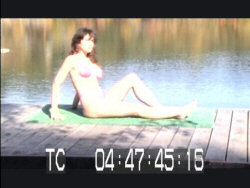 The result was an entry that tied the 3 films together. The result was an entry that tied the 3 films together.
Narration:
The character of Allison narrates the flashbacks through voice-overs to link everything together with the events of the 1992 footage. This is all sound footage never before heard, and is the element which makes it all work.
Chronology:
In some parts, scenes are put in context of proper order i.e. Angela's bandaged-head origin is placed before other Angela SC1 scenes as there is no use trying to keep the mystery element of the original. In others the editing plays fast and loose, where the only importance is linking the last scene to the next. Scenes frequently switch back and forth between the 3 films in order to push various points.
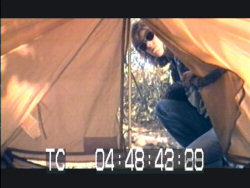 We open with "Allison" sitting on the lakeside dock. Camera pans up to the cliff where a lone tent stands... which then seamlessly intercuts back and forth with the SC3 footage of Herman/Jan in the tent and Angela's murdering of them. Other examples: The scenes of Alison running through the woods intercut with Angela chasing Molly through the woods circa SC2. In the campfire scene that opens SC2, when Phoebe talks about the Arawak murders, each description cuts back to those kills in the original SC. One of my favorite bits is where dialogue from SC2 about "why are you so fucked up" collapses into one of those evil stare shots of Angela from the original. By re-arranging scenes, things you've seen before are given a new context and therefore you might think of them in different ways by seeing their presentation here. We open with "Allison" sitting on the lakeside dock. Camera pans up to the cliff where a lone tent stands... which then seamlessly intercuts back and forth with the SC3 footage of Herman/Jan in the tent and Angela's murdering of them. Other examples: The scenes of Alison running through the woods intercut with Angela chasing Molly through the woods circa SC2. In the campfire scene that opens SC2, when Phoebe talks about the Arawak murders, each description cuts back to those kills in the original SC. One of my favorite bits is where dialogue from SC2 about "why are you so fucked up" collapses into one of those evil stare shots of Angela from the original. By re-arranging scenes, things you've seen before are given a new context and therefore you might think of them in different ways by seeing their presentation here.
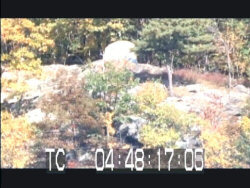 For those that lament how SC1 and SC2&3 are too different from each other, SC4 retroactively patches things up by emphasizing the shared elements of all 3, and also by switching up music scores from one, transplanted into scenes of another. By this, the transitions between the films are much smoother. For those that lament how SC1 and SC2&3 are too different from each other, SC4 retroactively patches things up by emphasizing the shared elements of all 3, and also by switching up music scores from one, transplanted into scenes of another. By this, the transitions between the films are much smoother.
There's actually a neat match-cut between a character in old footage against one in the SC4 footage, which creates (for the thinking fan) a pretty big implication for what the cut together footage really means for the story and continuity.
Conclusion:
At the very most it's a valid entry in its own right, at the very least it's a fun "best of". Is it the ideal final fate of The Survivor? No. Does it make the best of a bad situation? Of course. What's a better legacy, an edited composite or an "never finished film"? You know the answer. Before the various future chapters of the saga play out, this is a staunch reminder and summarization of what has become before.
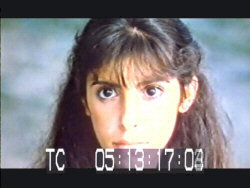 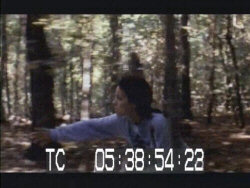
|

